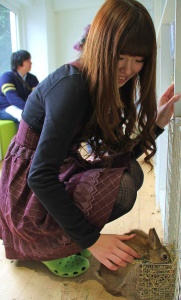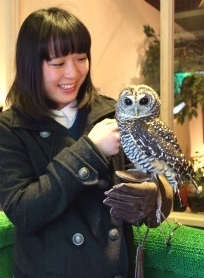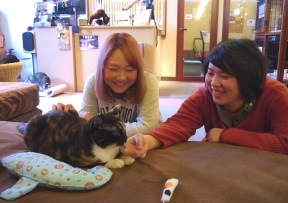Animal Cafes – The New Middle between Zoo Animals and Pets for Animal Lovers in Japan? (April 2014)
post date : 2014.04.28
Animal Cafes
– The New Middle between Zoo Animals and Pets for Animal Lovers in Japan?
Author: Ayako Wasiliew, FPCJ Intern
“It’s a really exotic place. It’s my first time today, but I’d like to come to places like this more often in the future”, says 23-year-old English teacher Paoletta Malialani from the United States, sitting in Tori No Iru Cafe in Koto-ku, Tokyo, which opened in late 2012. There, visitors can have some drinks while they watch different types of birds like parrots, canaries, hawks and even owls. They can also enter a room separated by glass where the hawks and owls are and choose one to perch on their arm for five minutes.
(Photo) A woman holding an owl on her arm, with a special falconry glove (Tori No Iru Cafe)
These animal cafes are designed to provide services so that people can interact with animals and spend time relaxing with them, instead of just keeping animals in the shops. Cat cafes and dog cafes have become widely known in Japan, and now animal cafes are becoming even more diverse, such as with rabbit, bird, and goat cafes.
 They are getting more and more attention from overseas tourists. In Usagi Cafe Ohisama, a rabbit cafe in Setagaya-ku, Tokyo, Ms. Asami Yoshimura, the owner, confirms that many Asian visitors come, learning about it through a guidebook or other resources. “I’ve heard that animal cafes are rare in other countries. So, overseas tourists seem to come to satisfy their curiosity. They take many pictures and look around, but sometimes hesitate to touch the rabbits, although there are of course some foreigners who just fall in love with the rabbits.”
They are getting more and more attention from overseas tourists. In Usagi Cafe Ohisama, a rabbit cafe in Setagaya-ku, Tokyo, Ms. Asami Yoshimura, the owner, confirms that many Asian visitors come, learning about it through a guidebook or other resources. “I’ve heard that animal cafes are rare in other countries. So, overseas tourists seem to come to satisfy their curiosity. They take many pictures and look around, but sometimes hesitate to touch the rabbits, although there are of course some foreigners who just fall in love with the rabbits.”
(Photo right) A woman gently stroking a rabbit’s back as it feeds (Usagi Cafe Ohisama)
Mr. Takashi Harada, president of Yaseisha Co., Ltd. in Suginami-ku, Tokyo, a publishing company which has managed a database of the pet industry in Japan for more than 40 years, says that animal cafes are a relatively new market within the last decade or so, but they have become widespread in the past five years. “As the variety of pets people can afford has increased, animal cafes have also diversified; some of the unique cafes with rather rare animals have got a lot of attention,” explains Mr. Harada.
(Photo) Two women enjoying a relaxing time (Neko No Iru Kyukeisho 299)
The cat cafe Neko No Iru Kyuukeisho 299 (Nikukyu) - in Toshima-ku, Tokyo, confirms that the number of visitors coming has increased from 2,000 visitors a month when its first cafe opened in Machida City, Tokyo, in 2005, to 4,000 now. Mr. Norimasa Hanada, the owner, provides his analysis: “Pet shops and zoos can’t satisfy the needs of the people anymore. We live in a high- stress society nowadays, as you might see in the high suicide rate. Due to the high stress, people want to relax through looking at, touching and loving cute animals.” Still, there are many people who “want to, but cannot keep pets,” due to their living environment such as apartments which do not allow pets or the increasing number of people living alone, and shows the reason why animal cafes have enjoyed high popularity. According to his personal research, there were 207 cat cafes in Japan as of April 2014.
------------------------------------------------------------------------------------------------------------------------
<Reporter’s Comments>
The first time I ever heard about animal cafes was when I watched a documentary about an American pop singer few years ago. When the singer was in Japan during her world tour, she spent her day off in a cat cafe.
When I came to Japan few months ago, I heard about various other types of animal cafes which are popular now: dog cafes, rabbit cafes, owl cafes, goat cafes … the owl cafe sounded especially exotic – for me, owls were animals who lived in the forest or in the zoo, so I couldn't really imagine what to expect during my research for the article. And since animal rights are quite strict in Europe where I come from, I was also a little bit skeptical towards animal cafes concerning their treatment of animals.
When I visited some animal cafes while working on this article, I was surprised in a positive way because all of the cafes I visited were very clean and had very good hygiene standards. Interactions between the guests and the animals were strictly regulated – guests had to sanitize their hands before touching the animals and there were “resting corners” prepared for the animals to rest. In most cases, children under a certain age were not allowed, in order not to put the animals under too much stress.
While speaking to the shop owners, I really felt how much they love their animals and how they want to share that love with the people who come to their cafe. I also learned during my research that some animals in the cafes were former strays and in some other cafes they organize adoptive families for animals, which I think could be a good example for the future of the pet industry in other countries in the world.
*Some of the linked pages are available in Japanese only.
(Copyright 2014 Foreign Press Center/Japan)





